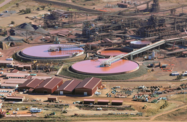In a bid to reduce the negative environmental externalities associated with heavy coal-fired electricity generation, South Africa is stepping up efforts to increase the role renewable energy plays in its increasingly overstretched electricity sector, pushing ahead with a series of programmes aimed at harnessing the nation’s vast alternative resources.
The government has moved to bring the agencies charged with promoting sustainable energy use under one roof, launching the South African National Energy Development Institute (SANEDI) on July 19. The new organisation, which will drive the research and development of indigenous green-energy innovations in partnership with science councils, universities and private industry, combines two previous bodies, the National Energy Efficiency Agency and the South African National Energy Institute.
The country is already moving to strengthen the contribution of renewables to its energy sector. The Department of Energy (DoE) is in the final stages of sealing up to 28 renewable energy proposals that were first accepted in December 2011, with the signing of the implementation, connection and power purchase agreements for a raft of projects set for August.
The initial projects – the first stage of the department’s Renewable Energy Independent Power Producer Programme (REIPPP) – comprise 18 solar photovoltaic projects with a total capacity of 631.53 MW; two concentrated solar power projects, with 150 MW of combined capacity; and eight onshore wind developments, representing 633.9 MW.
A second round of 19 projects were evaluated in May, and calls for a third series of proposals will be issued in the near term, part of the government’s programme to have at least 3725 MW of renewable energy generation capacity installed by 2016, with the first projects forecast to come online by 2014.
While the government is keen to promote renewable energy, the delays in its first round of REIPPP projects do highlight difficulties, including financial backing for less-conventional and smaller-scale developments. However, if this initial round of REIPPP projects can prove to be viable, investors will likely be quicker on the up take for later generations of renewable power generation.
However, while SANEDI and schemes such as REIPPP represent the government’s commitment to green energy, the country is keen to maintain as diversified a mix as possible, not only to avoid repeats of the load-shedding issues it faced in 2008 but also to reduce exposure to potential swings in commodity prices.
This is most evident in the government’s continued efforts to expand nuclear power generation. Dipuo Peters, the minister of energy, used the launch of the new SANEDI agency to underscore the government’s commitment to nuclear energy, along with the more traditional use of coal as an energy source.
“We need to use and will continue using nuclear energy for feeding, healing, energy and water provision,” Peters said.
According to the minister, South Africa has plans to build nuclear power stations with a combined capacity of 9.6 GW by 2030, with at least six such plants being considered in addition to the one station already in operation, with their output dwarfing that of the proposed alternative energy programme. Firms from China, South Korea and Russia are among those contending for the lucrative contracts that will stem from South Africa’s atomic energy programme, with Russian state-owned nuclear energy group Rosatom opening a local office in mid-July to promote its interests.
Currently, coal dominates South Africa’s energy mix, accounting for 73.4% of primary energy and 90% of electricity in 2010, and while diversification is a primary goal, the carbon-based fuel will likely maintain its primacy for many decades to come, with the DoE estimating that coal will continue to be used for the next 100 years, with the minister saying it was essential, “as long as we want to keep the lights on”.
Still, the push to promote renewable energy is attracting interest from overseas. In late July, Chinese firm Powerway Renewable Energy announced it would be investing $1.2m to build six factories in South Africa to produce mounting and tracking systems for solar photovoltaic plants.
Benson Wu, the CEO of Powerway, said the investment aimed to take advantage of the anticipated growth in solar energy in the South African market, with his firm foreseeing the need to supply mounting structures for over 500 MW of solar farms annually.
As long as the government can maintain the private sector’s enthusiasm for alternative energy projects, and encourage financiers to back such schemes, more such developments will get off the ground in the years to come. However, the challenge will be to ensure they are fostered through their formative stages and allowed to expand into businesses that generate returns, as well as electricity.

